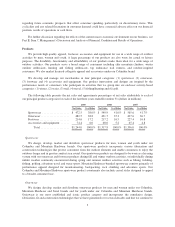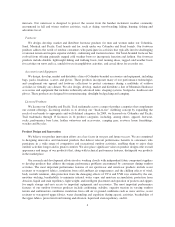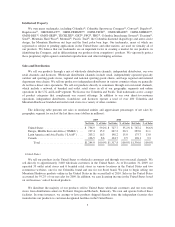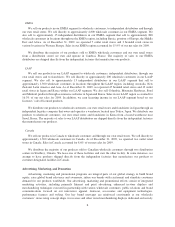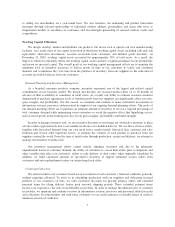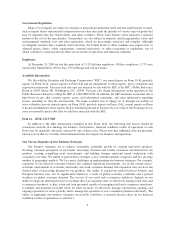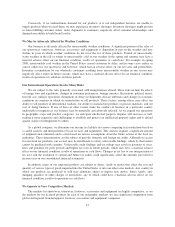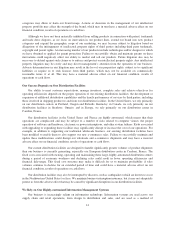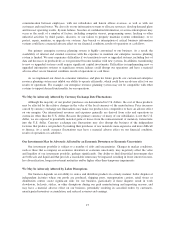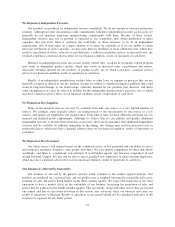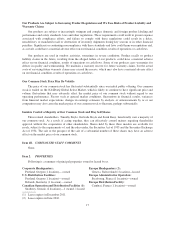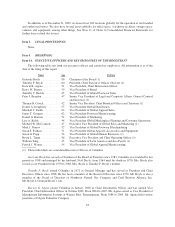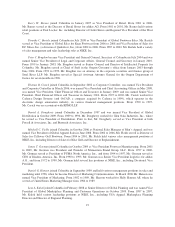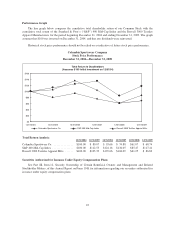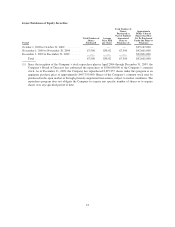Columbia Sportswear 2009 Annual Report Download - page 20
Download and view the complete annual report
Please find page 20 of the 2009 Columbia Sportswear annual report below. You can navigate through the pages in the report by either clicking on the pages listed below, or by using the keyword search tool below to find specific information within the annual report.Retailers who are our customers often pose our most significant competitive threat by marketing apparel,
footwear and equipment under their own private labels. For example, in the United States, several of our largest
customers have developed significant private label brands during the past decade that compete directly with our
products. These retailers have assumed an increasing degree of inventory risk in their private label products and,
as a result, may first cancel advance orders with us in order to manage their own inventory levels downward
during weak economic cycles.
We also compete with other companies for the production capacity of independent factories that produce our
products and for import quota capacity. Many of our competitors are significantly larger than us, have
substantially greater financial, distribution, marketing and other resources than we have, and have achieved
greater brand strength than we have.
Increased competition may result in reduced access to production capacity, reductions in display areas in
retail locations, reductions in sales, or reductions in our profit margins, any of which may have a material adverse
effect on our financial condition, results of operations or cash flows.
We May be Adversely Affected by Retailer Consolidation
When our wholesale customers combine their operations through mergers, acquisitions, or other
transactions, their consolidated order volume may decrease while their bargaining power and the competitive
threat they pose by marketing products under their own private labels may increase. Some of our significant
customers have consolidated their operations in the past, which in turn has had a negative effect on our business.
As many retailers face increased financial pressure from significant decreases in consumer spending and
continued economic uncertainty, we expect retailer consolidation to continue, which may have a material adverse
effect on our financial condition, results of operations or cash flows.
We Face Risks Associated with Consumer Preferences and Fashion Trends
Changes in consumer preferences or consumer interest in outdoor activities may have a material adverse
effect on our business. In addition, changes in fashion trends may have a greater impact than in the past as we
expand our offerings to include more product categories in more geographic areas. We also face risks because
our business requires us and our customers to anticipate consumer preferences. Our decisions about product
designs often are made far in advance of consumer acceptance. Although we try to manage our inventory risk
through early order commitments by retailers, we must generally place a significant portion of our seasonal
production orders with our independent factories before we have received all of a season’s orders, and orders
may be cancelled by customers before shipment. If we or our customers fail to anticipate and respond to
consumer preferences, we may have lower sales, excess inventories and lower profit margins, any of which could
have a material adverse effect on our financial condition, results of operations or cash flows.
Our Success Depends on Our Use and Protection of Intellectual Property Rights
Our registered and common law trademarks have significant value and are important to our ability to create
and sustain demand for our products. We also place significant value on our trade dress, the overall appearance
and image of our products. From time to time, we discover products that are counterfeit reproductions of our
products or that otherwise infringe on our proprietary rights. Counterfeiting activities typically increase as brand
recognition increases, especially in markets outside the United States. Increased instances of counterfeit
manufacture and sales may adversely affect our sales and our brand and result in a shift of consumer preference
away from our products. The actions we take to establish and protect trademarks and other proprietary rights may
not be adequate to prevent imitation of our products by others or to prevent others from seeking to block sales of
our products as violations of proprietary rights. In markets outside of the United States, it may be more difficult
for us to establish our proprietary rights and to successfully challenge use of those rights by other parties. We
also license our proprietary rights to third parties. Failure to choose appropriate licensees and licensed product
13


